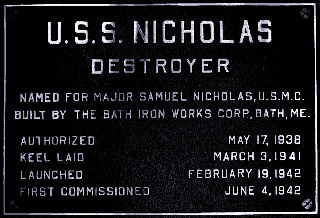
Arriving in the Pacific in September, she joined the Guadalcanal operation, which was already in progress. Soon sisters O’Bannon, Fletcher, De Haven, Radford, Jenkins, La Vallette, Chevalier, Strong and Taylor arrived and in March 1943, the survivors were formed into Destroyer Squadron 21, with Nicholas as flagship.
For the next seven months, these ships fought their way up the Solomon Islands chain through many more bombardments and night surface actions, including the Battles of Kula Gulf and Kolombangara. Then at the end of October 1943, the squadron was assigned to screening duty for the the Gilbert Islands operation before sailing home to Mare Island Navy Yard for the “Nick’s” only refit of the war.

“I am proud to present to you a fitting token of the respect and esteem which this ship, her officers and her men have well earned throughout the Navy,” began Admiral Nimitz in his remarks to the crew at Nicholas’s Presidential Unit Citation ceremony on 28 January 1944. For her action in 1943, she was one of the first ships to be presented this high honor.
“To say the record speaks for itself is not enough,” he continued. “In this case the record of the Nicholas is in a sense the record of one entire phase of the Pacific war.”
Much the same was true of other ships of DesRon 21, of which Nicholas was flagship. It including the name ship of her class (Fletcher), two other individual Presidential Unit Citation awardees (Radford and O’Bannon), a Naval Unit Commendation recipient (Taylor) and four of the nine destroyers that earned fifteen or more service stars in World War II (O’Bannon, Nicholas, Fletcher and Taylor).
Admiral Halsey also acknowledged the “Nick.” As the war’s end approached, he directed that she and O’Bannon be present in Tokyo Bay for the Japanese surrender. En route, she proceeded ahead of the formation approaching Japan to receive emissaries and pilots for distribution among the fleet, led the Flagship Task Group into Tokyo Bay, and later transported Allied and American representatives to and from the surrender ceremony aboard Missouri.
By this time, Nicholas had earned sixteen battle stars, a total surpassed only by O’Bannon, and her thirty stars through three wars is the highest total for any US Navy ship.
Thanks to circumstances such as these, the “Nick” also emerged as one of the most photographed destroyers of World War II, with more than 300 images taken of or from her preserved at the National Archives and at least another 300 in private collections.
In February 1944, Nicholas arrived back in the western Pacific to resume screening convoys and the fleet (sinking two submarines) and bombarding shore positions in New Guinea, the Philippines and Borneo. This duty sometimes kept her at sea for many weeks, to the point where she ran low on food.
After hostilities ceased on 15 August 1945, Admiral Halsey ordered Nicholas, O’Bannon and Taylor to screen his flagship Missouri as she entered Japanese home waters. On 27 August, Nicholas proceeded ahead of the formation to receive Japanese emissaries, pilots and interpreters. Two days later, she led the Flagship Task Group into Tokyo Bay.
Nicholas also featured in the events surrounding the formal Japanese surrender on 2 September. Her assignment that day was to transport American and Allied representatives out to Missouri at anchor for the ceremony, which the crew could observe through binoculars. On 1 October, after a month spent repatriating prisoners of war, the Nick departed for home and arriving at Seattle in time for the Navy Day celebration there.
Converted and then recommissioned as an escort destroyer (DDE) in 1951, she served thereafter off Korea and in continued deployments to the western Pacific.
Over seven months in 1959–60, she received a FRAM II conversion at Pearl Harbor, one of only three Fletchers (with Radford and Jenkins) to receive this modification.
Thereafter, she served with the “Pineapple Fleet” and was maintained there, returning to the West Coast only once.
Following a joint 25th birthday celebration with Fletcher, Nicholas completed a total of 14 Western Pacific deployments, including service in the Tonkin Gulf and with the recovery task forces for the Apollo 8 and 9 space missions.
Nicholas was fast, even among sister ships, throughout her lifetime. She achieved 37.1 knots at 2,589 tons during her builder’s trials1 and over 36 knots on one occasion after more than a year at sea2. She may have been even faster after her FRAM conversion.
Finally in 1970, having become the navy’s oldest active destroyer, the “Nick” was decommissioned in a ceremony at Pearl Harbor (again side-by-side with O’Bannon), stricken from the Navy List, towed to Portland, Oregon, and broken up in 1972. At the time she was retired, only seven other Fletcher-class ships remained in service with the US Navy.
An estimated 4,000 officers and men served in her during her nearly 28-year career.
|
The ship looked the part that she was—“The Mistress of the Sea.”
|
|
— Destroyers Pacific, 28 January 1944.
|
1 Friedman, p118.
2 Deck Log, 6 July 1943.